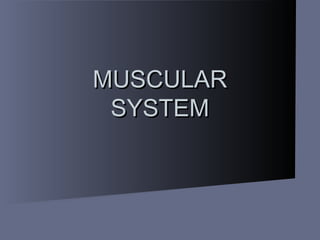
Mus.sys.01
- 2. The Muscular System The ability to move is an essential activity of the human body ½ our body weight comes from muscles Consists of over 600 individual muscles. 3 purposes: – – – Body movement Body shape Body heat (maintain temp.)
- 3. The Muscular System Body movements are determined by three types of muscles – Smooth (involuntary) – cannot be controlled by will. – Cardiac – control the contractions of the heart. – Skeletal (Voluntary) – can be controlled by will.
- 4. Function of Skeletal muscles Attach to bones to provide voluntary movement – Tendons: strong, tough connective cords – Fascia: tough, sheet-like membrane Produce heat and energy for the body Help maintain posture Protect internal organs Called striated (striped) because they have striations of alternating light and dark band
- 5. Functions cont’d. Fleshy body parts are made of skeletal muscles Provide movements to the limbs, but contract quickly, fatigue easily and lack the ability to maintain contraction for long periods – Blinking eyes, talking, breathing, eating, dancing and writing all produced by these muscles
- 6. Function of Smooth Muscle Called smooth muscle because they are unmarked by striations, small spindle shaped Unattached to bones, act slowly, do not tire easily and can remain contracted for a long time Not under conscious control so they are also called involuntary muscles Found in walls of internal organs (intestines, bladder, stomach, uterus, blood vessels)
- 7. Function of cardiac muscle Found only in the heart Involuntary muscle Requires a continuous supply of oxygen to function Cardiac muscle cells begin to die after 30 seconds of oxygen cut-off Striated and branched
- 8. Special muscles Sphincter (dilator) muscles are openings between – – – the esophagus and stomach The stomach and small intestines Walls of the anus, urethra and mouth Open and close to control passage of substances
- 9. Characteristics of Muscles All muscles have 4 common characteristics – Excitability – ability to respond to a stimulus (ie: nerve impulse) – Contractibility – muscle fibers that are stimulated by nerves contract (become shorter) and causes movement – Extensibility – ability to be stretched – Elasticity – allows the muscle to return to its original shape after it has been stretched
- 10. Definitions Adduction: – Moving a body part toward the midline – Increasing the angle between two bones or straightening the body part Abduction: – Moving a body part away from the midline Extention: – Decreasing the angle between two bones or bending body parts Rotation: – Turning a body part around its own axis Flexion: Circumduction: – Moving in a circle at a joint
- 11. Buildup of lactic acid caused by vigorous exercise where blood is unable to be transported: – MUSCLE FATIGUE State of partial contraction is called: – MUSCLE TONE Loss of muscle tone occurs when muscles are not used for a long period of time. Muscles atrophy (shrink in size and lose strength) and results in: – CONTRACTURES Foot drop is the most common type of contracture seen, but fingers, knees and other joints can be affected
- 12. MUSCLES YOU NEED TO KNOW THE FUNCTIONS OF: Biceps – flexes lower arm Deltoid – abducts arm; injection site Sternocleidomastoid – turns head Gastrocnemius – flexes sole of feet Latissimus dorsi – extends & adducts upper arm Pectoralis major – adducts and flexes upper arm intercostals – moves ribs for breathing
- 13. Trapezius – extends head, moves shoulder Triceps – extends lower arm Gluteus maximus – extends thigh; injection site Sartorius – abducts thigh, flexes leg Vastus lateralis – extends leg Rectus abdominus – compresses the abdomen Rectus femoris – flexes thigh & extends lower leg Tibialis anterior – flexes and inverts foot
- 14. FIBROMYALGIA Chronic, widespread pain in specific muscle site; numbness and tingling in arms or legs; headaches Cause unknown Treat symptoms – pain relief; stress reduction and muscle relaxers MUSCULAR DYSTROPHY Group of inherited diseases that cause chronic, progressive muscle atrophy resulting in total disability and early death No cure Treatment used to slow progression of disease
- 15. MYASTENIA GRAVIS Chronic condition where nerve impulses are not transmitted correctly leading to progressive muscular weakness and paralysis; affects respiratory muscles and can be fatal Cause unknown Treatment is supportive MUSCLE SPASMS/CRAMPS Sudden, painful involuntary muscle contractions Caused from overexertion, low electrolytes or poor circulation Treat by applying gentle pressure and stretching of the affected muscle
- 16. STRAIN Overstretching of a muscle or tendon frequently in legs, back or arms Caused by sudden muscle exertion Treated by resting, muscle relaxants, or pain medications, elevation of extremity and applying hot/cold compresses
- 17. Problems from lack of Contractures movement – Tightening and shortening of a muscle resulting in a permanent flexing of a joint Muscle atrophy – Muscles become weak and joints become stiff Circulatory impairment – Blood clots and pressure ulcers can develop Mineral loss – Especially calcium from the bones making bones brittle and easily to be fractured Other problems – Poor appetite; constipation; urinary infections; respiratory problems; and pneumonia
- 18. 8 rules of good body mechanics Maintain broad base of support (8-10 in.) Bend from hips and knees to get close to object Use strongest muscles: shoulders, arms, hips, thighs Use weight of body to help push/pull Carry heavy objects close Avoid twisting body; turn whole body when changing direction Avoid bending for long periods Get help if object is too heavy